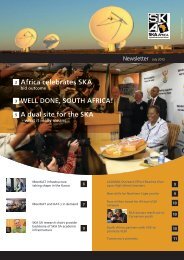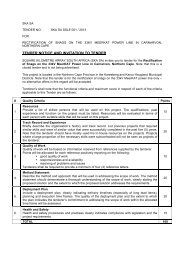Number 19 - March 2013 - SKA
Number 19 - March 2013 - SKA
Number 19 - March 2013 - SKA
You also want an ePaper? Increase the reach of your titles
YUMPU automatically turns print PDFs into web optimized ePapers that Google loves.
S K A N E W S M A R C H 2 0 1 3A perspective from Dr Rick Perley, scientistat the National Radio Astronomy Observatory,on the recent 3GC workshop at Port Alfred.Rick is based in Socorro, NM, USA, where thescience operations centre for the Very LargeArray is located.“This was extremely useful to students and researcherswho want to be involved in the design of various subsystemsof <strong>SKA</strong>, such as electronics or software, but previouslyhad a limited exposure into the complexity andoutstanding issues of calibration,” says Dr Slava Kitaeff,research associate in the field of high performance computingat the International Centre for Radio AstronomyResearch at the University of Western Australia. “It is alsogreat to see how the international radio astronomy communityis coming together to address the most challengingtechnical issues of the <strong>SKA</strong>, and calibration iscertainly one of them.”Dr Francesco de Gasperin, research associate at the Universityof Hamburg in Germany, agreed that the workshopwas extremely useful. “It was a rare opportunity to find allthe top scientists in this field from around the globe inone location, along with students in the field,” he said.“It created a very productive environment for experts anda perfect place for students to learn. This kind of workshopalso underlines the leading role that South Africais taking in the global radio astronomy community.”The meeting was sponsored by <strong>SKA</strong> SA, Rhodes University,and RadioNet3.Find out more athttps://sites.google.com/a/ska.ac.za/3gc3/home“If you stare at this plot long enough, you’ll understandwhy CLEAN works.” – Ludwig Schwardt, <strong>SKA</strong> SA.(Voted best statement of the conference.)Thirty five years ago, I arrived at the VLA as thefirst of a group of young researchers, looking forinteresting challenges. The builders of the array— which was then about 1/3 completed —handed us a challenge: ‘We don’t know how tocalibrate this new instrument — we want you tofigure out how to do this’. Our efforts were successful.The array succeeded beyond all expectations,and great science was done.Today, there is a new set of arrays rising –MeerKat, ASCAP, LOFAR, MWA, and the potentialof the <strong>SKA</strong>. These new arrays all share onething: They have wide fields of view at low frequencies.This brings a new host of dauntingcalibration challenges, far more complex thanthose facing the early VLA. The success of thesenew instruments depends upon finding solutionsto these challenges. And the solutionswill come from a new generation of youngresearchers.The 3GC series of workshops is designed tobring together the leading researchers fromthe many institutions contributing to these newarrays. It combines the wisdom of the ‘grizzledveterans’ with their deep understanding of thepracticalities, with a rising new generation, whobring new methods, fresh thinking, and boldapproaches.The third 3GC workshop in Port Alfred, SouthAfrica was a sparkling success. It showed thatthere is great progress in finding how these newand exciting new instruments can be made todo great new science. New concepts, and newapproaches, were vigorously discussed anddebated. I am sure that all who participated willreturn to their institutions, ready to experimentwith and to implement these new ideas.Although success cannot be guaranteed – thisis the nature of research – great progress hasbeen made, and we can assuredly look forwardto impressive and unanticipated new sciencefrom this new generation of arrays, driven bythis rising new generation.








